Before and After – Which Painting Style Do You Prefer?
This week, I share a revamp of a small painting and talk about painting style.
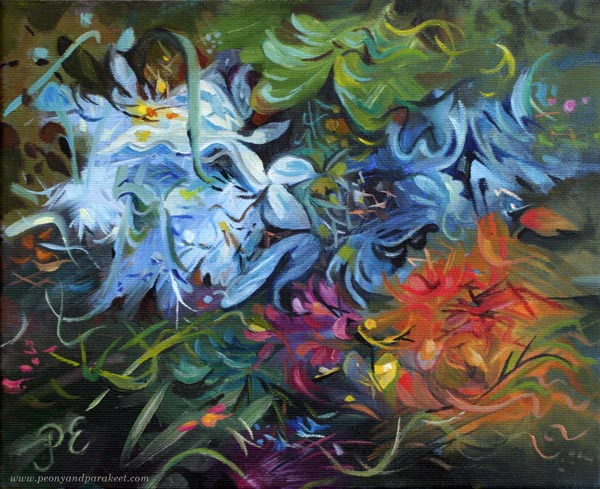
Here’s my newest piece that I am quite fond of. But wait! This isn’t totally new, but a revamped one.
Husband Didn’t Approve
Earlier this month, I made a small painting that didn’t get approval from my husband.
– “Unfinished,” he said.
– “No, it’s just loose and abstract,” I claimed.
But soon after, I considered adjusting something a little. My husband has good taste, and I appreciate his opinion. Like most Finns, he is brutally honest, and often that’s what I want to hear, even if it would hurt a bit.
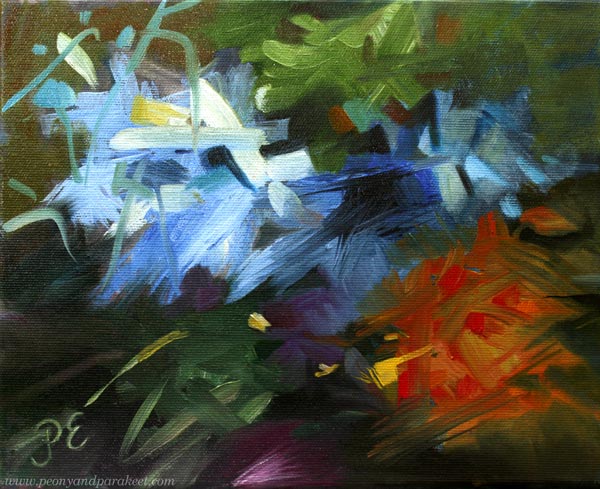
But what to do with this one? Maybe just make a couple of clumsy shapes a bit curvier. But after having a wonderful conversation about conventionality with a friend who is also an artist, I felt that I could do it – go from one extreme to another.
Several Levels of Style
During the last couple of months, I have been trying to define my approach to art as levels of some sort – when should I go abstract, when do I want to make illustrations, and when my style needs to be decorative or design-oriented.
I have always thought that these levels are connected to what supplies I use. Like this:
If I paint, I am more abstract.
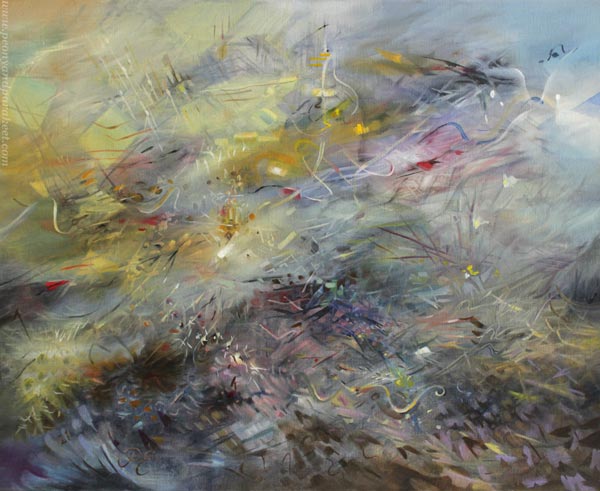
If I draw, I go in the illustrative direction.
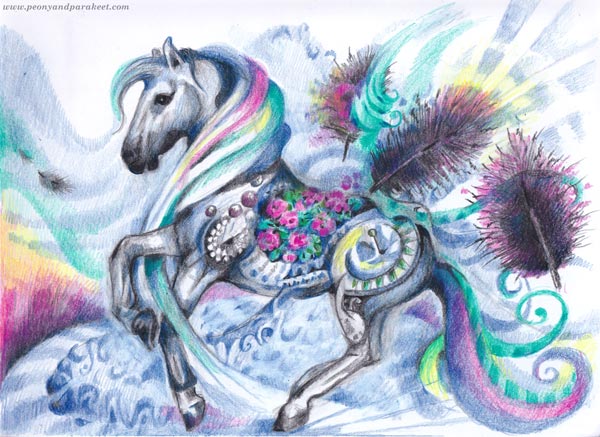
And if I embroider, it’s just decorative work for relaxation.
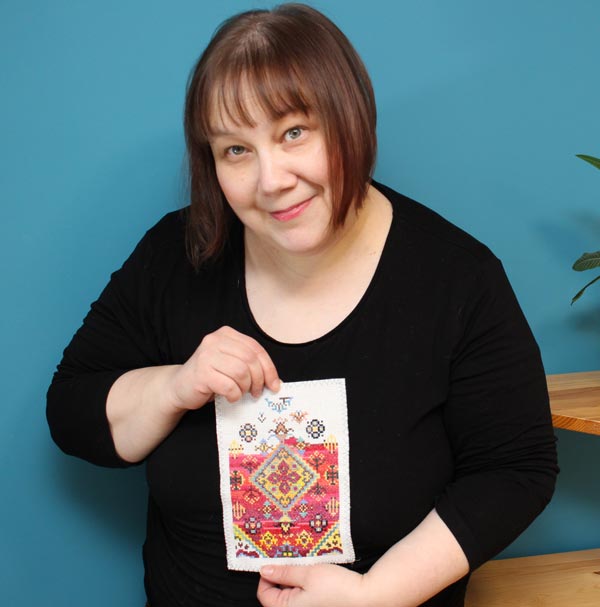
But it shouldn’t always have to be like that. The opposite could happen too.
Untraditional Use of Supplies – Mixing Levels of Style
Last summer, I started to do slow stitching – random simple stitches on fabric. Surprisingly, what first felt like decorative needlecraft started to produce abstract art. This piece is not traditionally decorative at all.
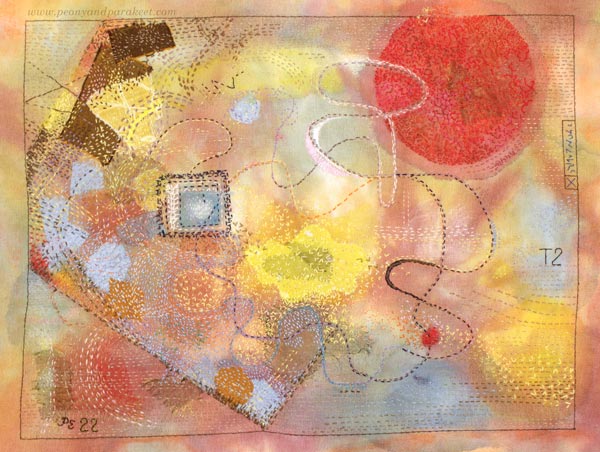
And many of my recent images in colored pencils have been quite abstract and painterly, like this spread from my colored pencil journal.
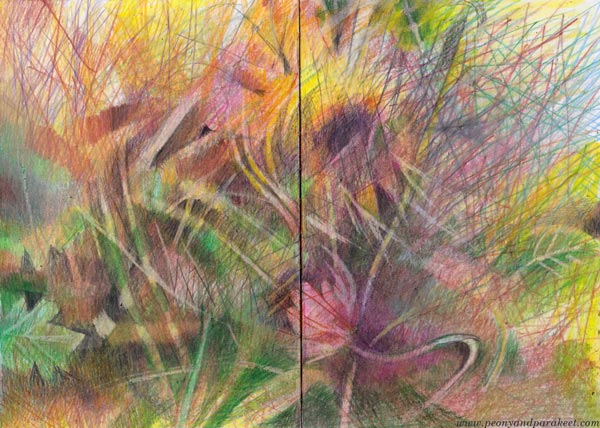
The art world is full of presumptions based on supplies.
Colored pencil artists replicate photos.
Watercolorists throw water on the paper and wait for the landscape to appear.
Abstract painters do it for interior design.
Decorative is reserved for folk artists.
And so on!
But I have come to the conclusion that supplies don’t define the levels of my style. I can freely choose how much I want to show each level of style in one piece.
So, we can break what’s expected and do what we want!
Inspiration from Many Styles
The same unrestricted approach applies to inspiration.
I went to Sinebrychoff Art Museum to see floral paintings, but the most inspiring piece was a traditional textile – what??? When I looked at the photos taken from the exhibition, it felt like a dirty secret.
There were many old masterpieces in oil, but a small traditional textile captivated me.
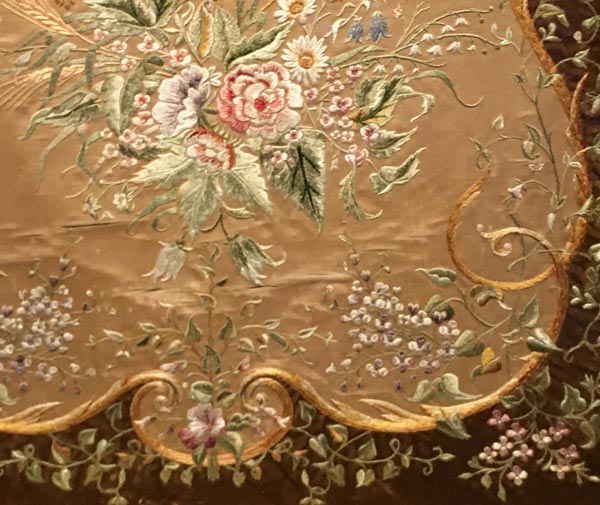
“How can I be so inspired by that?
I shouldn’t think about that anymore.
At least, don’t tell anyone!”
But my creativity has a mind of her own when it comes to inspiration. If I look at my Instagram saves, sometimes I like to see old palaces or churches, and other times I find simple and rural terribly inviting. I love old portraits, but I am not particularly fond of painting humans myself. I consume all kinds of kitsch – banal florals, round-eyed dolls, plastic horses – like crazy, but I also love modern and straightforward that’s not similarly pretty at all.
And now, my creativity told me to revamp that abstract painting and go wild with decorative strokes.
“Take it to the Kitsch goddess,” she shouted.
“No one will like it,” I heard myself saying. But then it hit me that maybe we could do it together. I asked my inner Kandinsky: “Would you go decorative with me?” He nodded quietly but without hesitation.
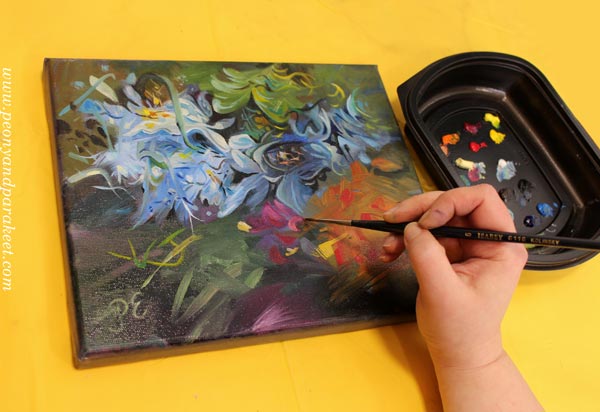
And so it happened that Mrs. Decorative, Mr. Abstract, and Miss Illustrative all painted together. It was a lot of fun!
Which One Do You Like Best – Before or After?
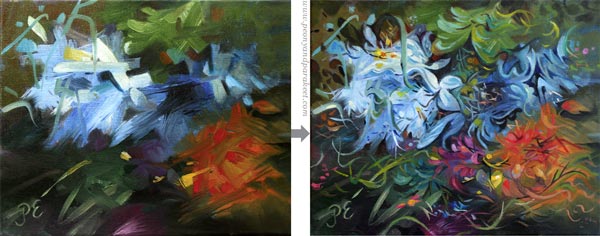
Which painting style do you prefer? It would be interesting to hear, leave a comment!
I have no regrets and my husband approved too. While I am waiting for the painting to dry, I glance at it frequently, smiling.
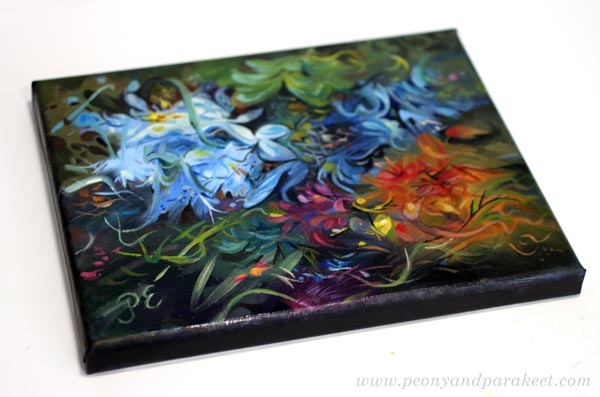
The painting follows a tradition but still feels like a breakthrough. I can now see further and wider. I could mix different painting styles in one big piece and bring a wider variety of inspiration into one work. So often, I have tried to move to the next level in technique, but now it feels that I need to level up artistic thinking!
News from My Little Studio
I have lots of painting work to be done in April. My private exhibition in June is still half-empty, but that’s partly a happy problem. My paintings have sold well, and I have a new prestigious gallery representation. The gallery is called Gumbostrand Konst och Form. I think it’s a great fit for my art because they also sell design pieces. Here’s my page on their website.
My home feels like a work in progress.
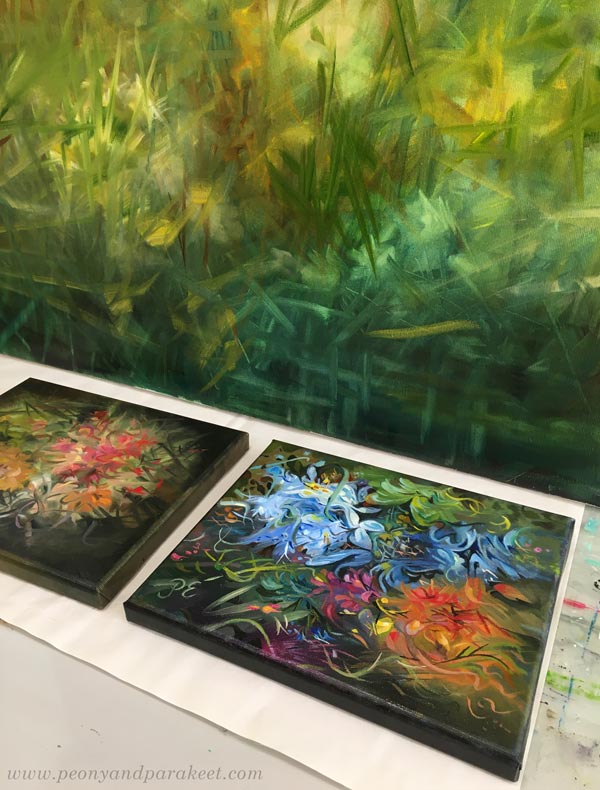
The little studio space has unfinished paintings, and big blank canvases are waiting in the library room.
I also have a new online class going on – Fun Botanicum!
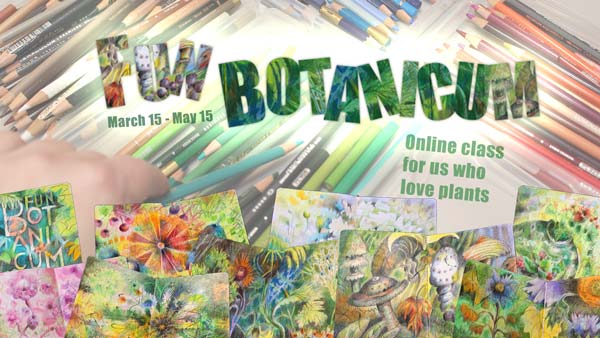
It’s so wonderful to see work from the students and have conversations about art. It makes all the other work less lonely, and I feel blessed to lead the lovely community. Especially now, when most of my spare time is spent worrying over the world situation, it feels good to be connected and also, serve others.
You can still hop in, sign up here!
Green Flowers in Colored Pencils
This week is about embracing green flowers and making your art stand out.
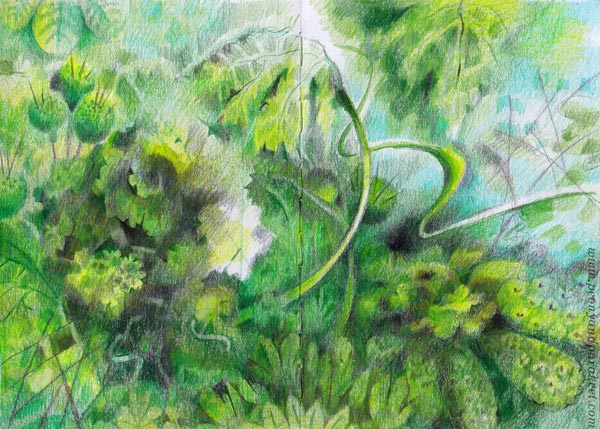
Last month, my husband let me choose flowers for my birthday. I picked green roses that had a hint of pink on their petals. Of course, there were plenty of colors available, but green ones touched my heart. I have always liked old romance novels where the emotions are kept under the surface, and I see a similar kind of suffocation in this bunch.
A rose dreams about becoming pink but sadly realizes that her petals are not much different from her leaves.
I feel a strong bond with green flowers because my art is very similar to their petals, only a slightly improved reflection of the ordinary self. My art goes only as far as I can imagine, and the imagination is often limited.
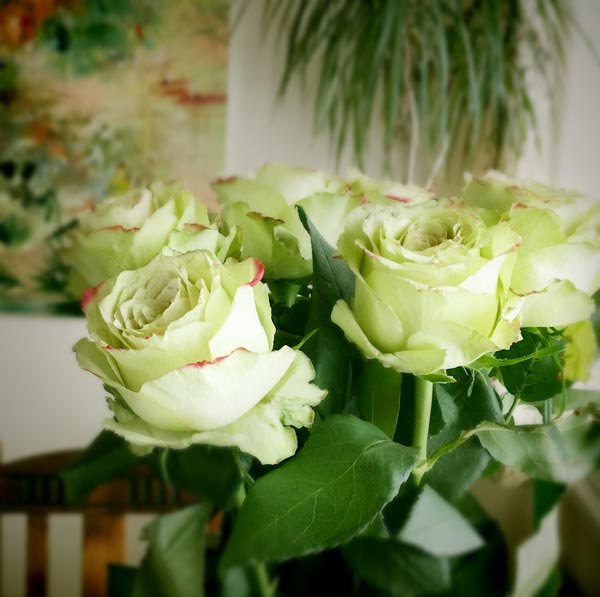
But green flowers can be enough. So, grand innovations can be replaced by many small tweaks.
Traditional or Not – Let’s Look at Jacob Marrel’s Flowers
Last week, I went to see old floral still lives at Sinebrychoff Art Museum. Still lives from the 17th century, like this one from Jacob Marrel, were my favorites. The subject is not creative: flowers in a glass vase, but small additions to a stereotypical interpretation make the painting stand out: butterflies and dragonflies, drops of water, red currants on the tabletop, black leaves that are easy to miss because they express the lighting so naturally, and the roses that sadly hang down, ready for withering.
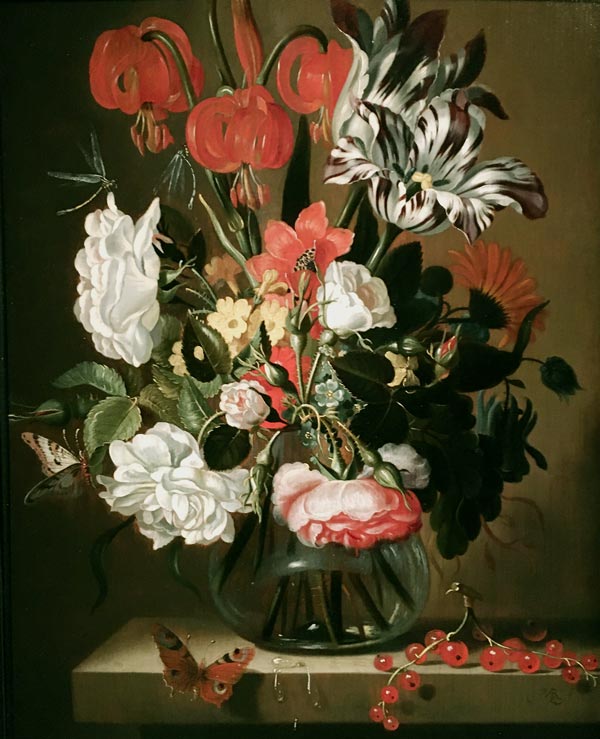
The best floral still lives from the 17th century are often Dutch, but Jacob Marrel (1613-1681) was German. He was a teacher, too, running a school for floral painters. I would love to turn back time and participate in his lessons! I would also have a question:
“Do you, Herr Marrel, think about the plant’s personality when you are painting it?”
Flowers Are Free Souls
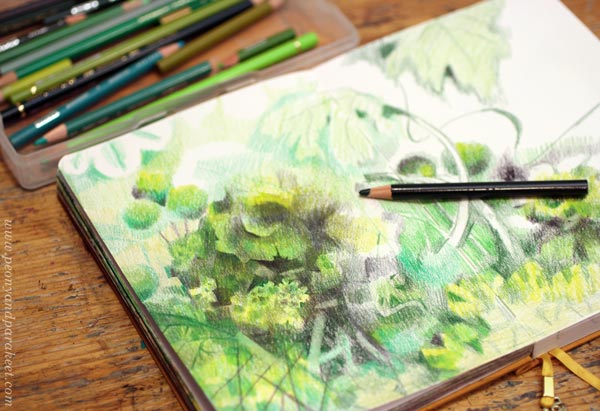
When I started this spread in my colored pencil journal, I felt that I just needed to let the flowers dance the way they wanted. So I didn’t sketch the big picture but worked little by little and endured the chaos, trusting that the flowers and leaves would find their natural gestures.
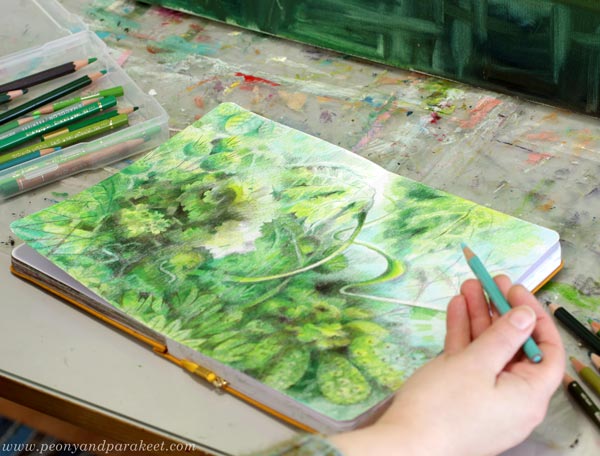
I want to let my art express itself as freely as possible.
How to Free the Flowers – 5 Tips
- Don’t make every flower similar, but let the diversity capture the viewer.
- Don’t differentiate flowers only with color but with shapes and lines too.
- Color a spot and ask what it wants, and allow green flowers – so, odd variations!
- Get inspired by the imperfection of reality! It’s natural to grow curvy, wither, have texture on the leaves, and get really dark or bright.
- Allow shapes and colors to breathe. You don’t have to know what every element in your drawing represents.
From Drawing to Painting
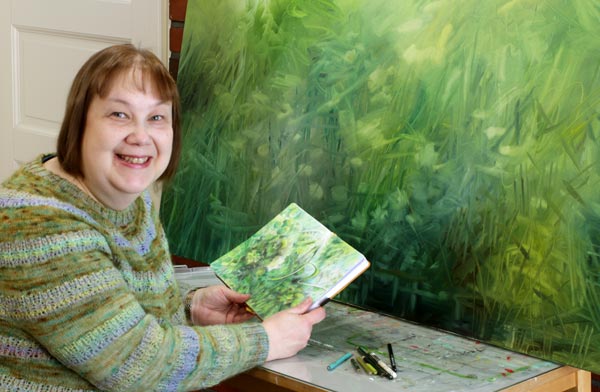
The first quarter of the year has been full of drawing and building the new class Fun Botanicum. But now a new series of paintings have started, and I have lots of big canvases to paint before the solo show in June. In the photo above, you see the first painting still in progress. My journal pages and my paintings live separate lives, but still, they inspire each other. It’s exciting to translate illustrative journal pages to more abstract paintings, and vice versa. I like this way of working a lot.
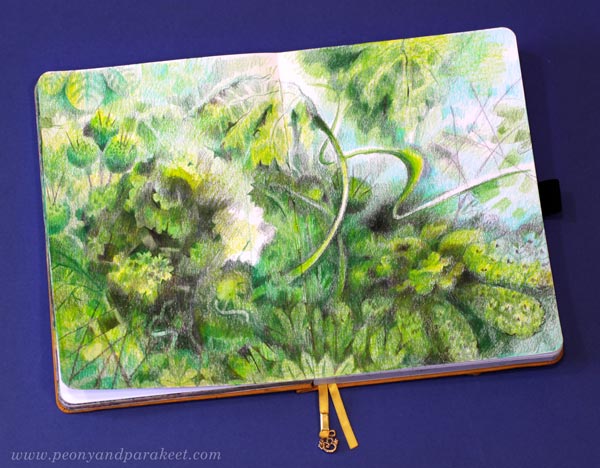
Now, when Fun Botanicum has started, I am also looking forward to seeing art from the participants: flowers, hays, fruits, berries, mushrooms … in all colors!

The new class Fun Botanicum has just started. You can still hop in and sign up!
Roaming Instinct – Why Not to Limit Artistic Inspiration
This post is about artistic inspiration and spirituality and enabled by Arts Promotion Centre Finland. This is the seventh blog post of the project, see the first one here, the second one here, the third one here, the fourth one here, the fifth one here, and the sixth one here!
My second big painting is called “Roaming Instinct.”
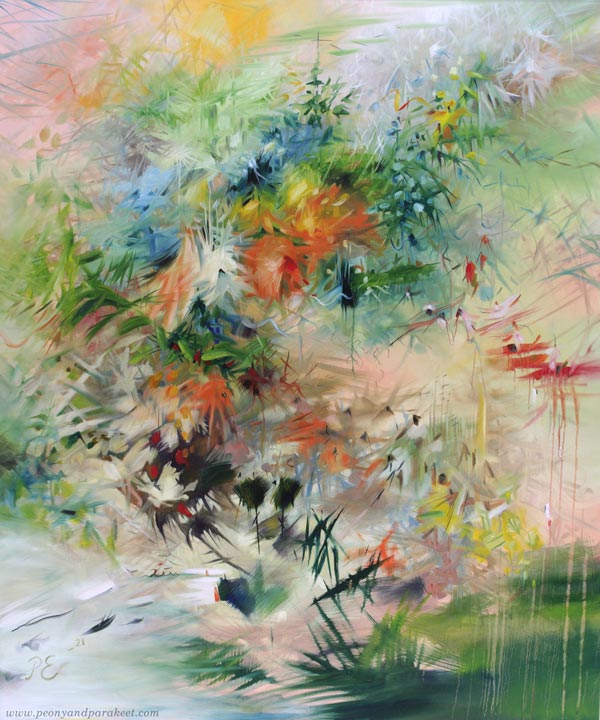
This painting and the previous big one have been really significant to me.
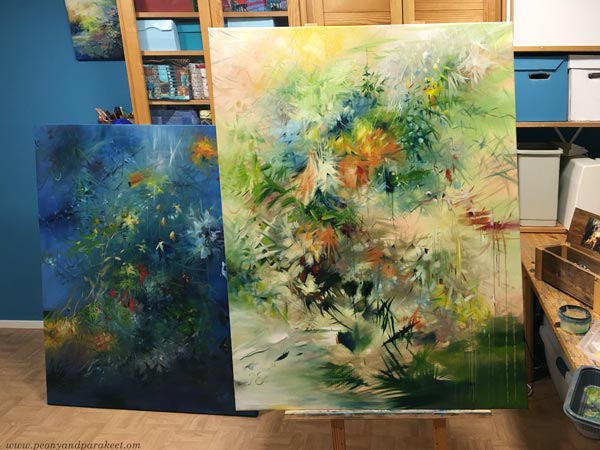
Regular practice and the big size have helped me to relax and let go – break the glass between the inner and the outer world, as Wassily Kandinsky would say.
Can There Be Too Much Artistic Inspiration?
As long as I have created art, I have been inspired by a variety of things. It has often felt like it’s too much.
Here are some:
- old portraits in fancy dresses
- houseplants and their pots
- midcentury-modern interiors
- colorful kitsch
- primitive dolls
- dressage horses
- English country gardens and cottages
- Tibetan yaks
- base jumping
- mountain climbing
- skateboards
- graffitis
- physics
- outer space
- mathematical algorithms
The list is ongoing and overwhelming!
I think this is not exceptional at all. The world is full of artistic inspiration. Like animals, we have a roaming instinct to explore further. No wonder they say that the hard choice for art-making is to choose what inspiration to pick.
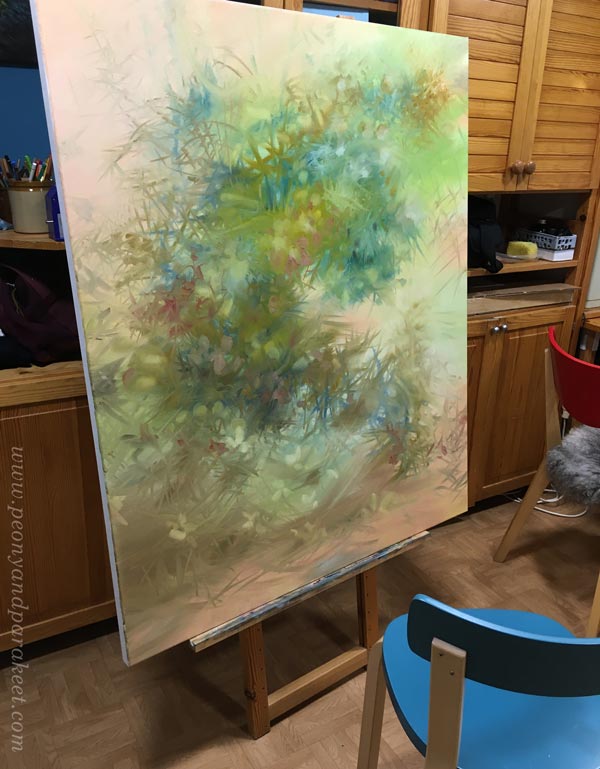
But recently I have felt like I don’t have to pick. No matter what I paint, I can bring it all together. If I paint a flower, it can look like a nomad, or a mountain, or a furry animal, or a space station, I don’t have to define.
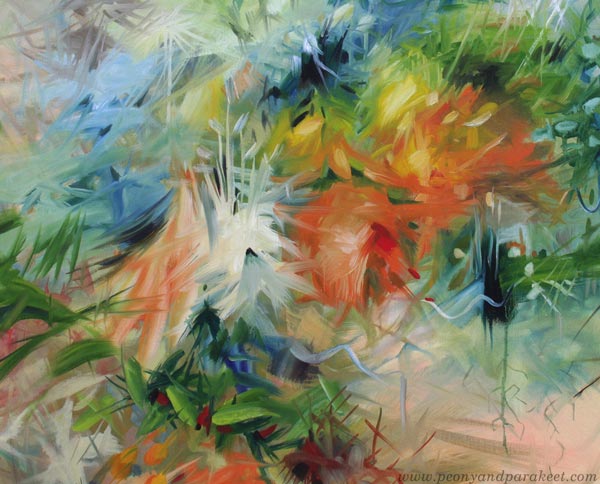
Every element can have a strong identity and the overall scenery can have a strong sense of location even if I can’t name it. Some people say my paintings are underwater sceneries, others see outer space. For me, they can be both, and yet neither. I feel I am delivering more than what can be labeled.
Finding Your Artistic Voice/Style/Spirituality/Identity – Whatever You Call It!
I have created art for a long time expecting to become better at what to pick and why. I assumed that art would make me know myself better and yes, it has. But it’s surprising that now when I am painting, it doesn’t really matter who I am and how I get inspired. My art is not to limit or to focus but to integrate.
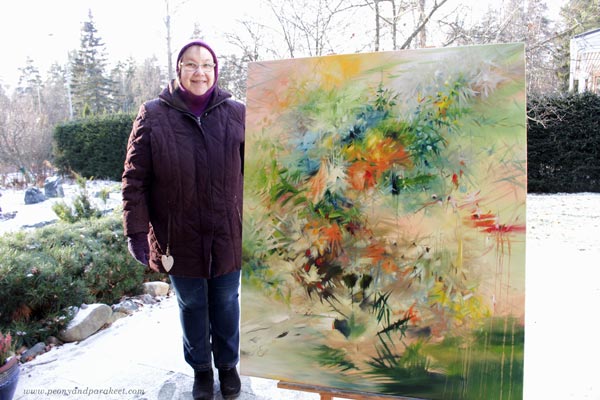
When I started the project, one of the goals was to get clearer about my spirituality. My question was: “Can a former engineer create spiritual art?”
At the moment, I find it difficult to separate physical from the spiritual. All material things seem to have a spirit and everything immaterial seems to have a figure. When I paint, they mix and merge, and after a while, the painting seems to have a mind of its own. It tells what it wants, and my job is to obey.
Does this make sense? What do you think?
Emotional Catharsis Through Intuitive Art
This post about catharsis and spirituality in art is enabled by the grant that I got from Arts Promotion Centre Finland. This is the fifth blog post of the project, see the first one here, the second one here, the third one here, and the fourth one here!
Recently I have thought about Wassily Kandinsky so much that he has become an imaginary character in my mind. He seems to enjoy this life after death, and I like him hanging around when I paint. This time it led to emotional catharsis – a very powerful experience. Here’s the story!
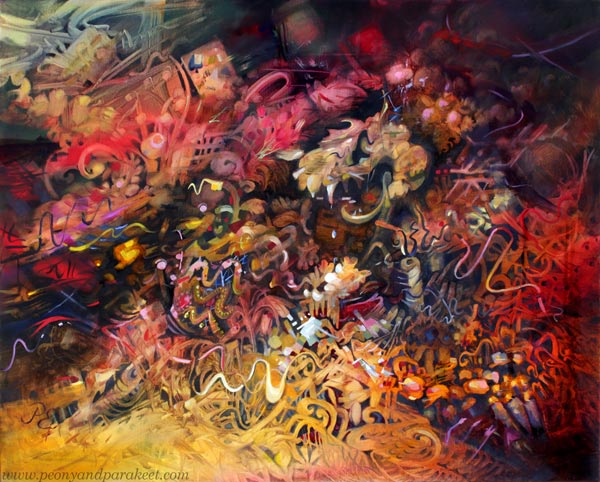
Let’s Go to The Dark Side!
One morning, before starting the painting, I read one of my recent blog posts to Wassily:
“Because expressing light is impossible without painting the darkness, I have decided to explore spirituality’s ultimate opposites as well. Like insolence, materialism, and money.”
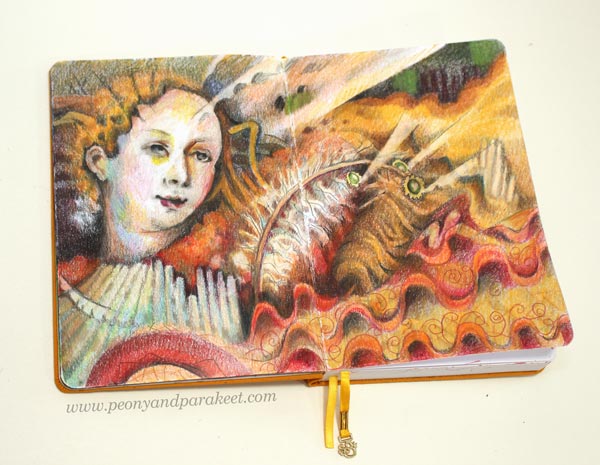
“Let’s do it!” Wassily immediately exclaimed with his Russian accent. “Let’s paint what money looks like! Do you like money, Paivi?”
The question alone was vulgar and intrusive, and the whole subject made me shiver. “What’s the problem? Haven’t you ever painted the dark side?” Wassily asked and looked confused and a bit more gentle too.
Well, I hadn’t. Not in this scale, anyway. The idea of spending the next few weeks with blacks and bloody reds felt heavy. In my life, there have been times when I had liked money too much, for example, when I sold IT solutions to big organizations. Secretly, it felt almost as good as making art. Back then, I bought lots of art supplies, but the time for using them was much more limited. Too limited.
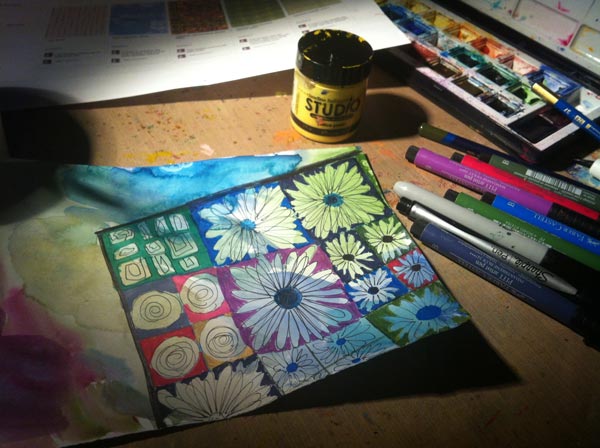
“Wassily,” I said, “money almost took me away from creating, so how can I create a painting about it?” But Wassily is a funny guy. He doesn’t answer questions that he wants me to answer through creating. Then he just stares at me silently like a watchdog, preventing the escape from the studio.
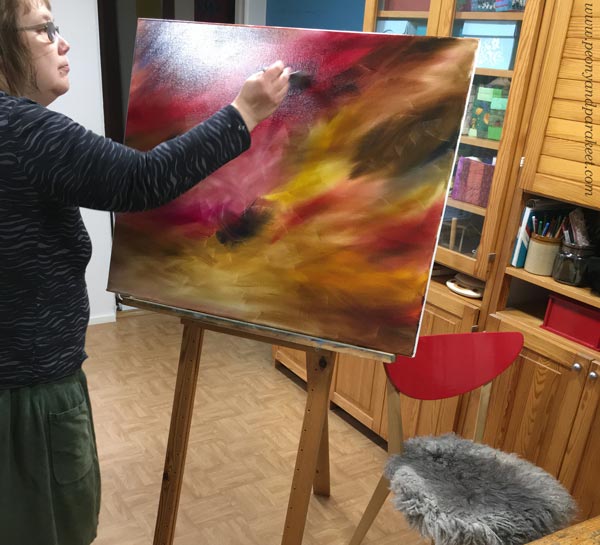
So I can do nothing but start.
From a Pet to a Beast
While filling the blank canvas, I tried to comfort myself by thinking about how money can be a good thing too, enabling grand and beautiful things.
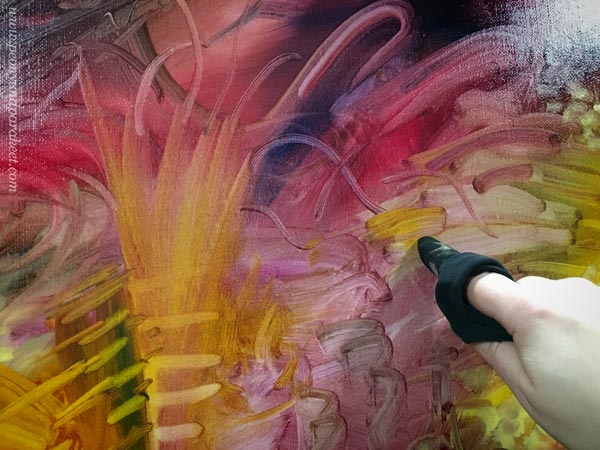
“I will paint all the luxury,” I said to Wassily and picked Indian Yellow, the color of gold.
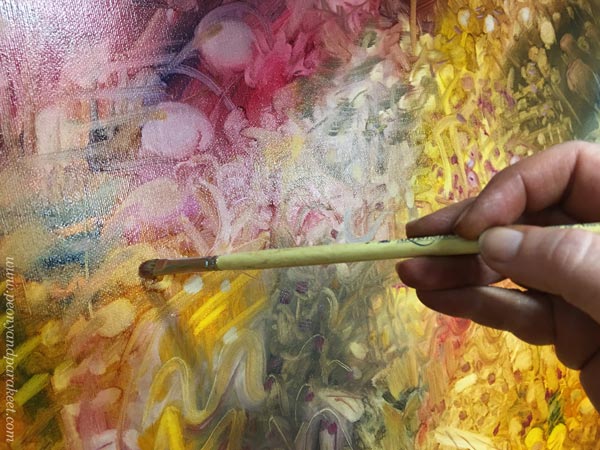
It all went fine for a long time. The painting was like a lion cub, cute and pretty at a young age, a true pet.
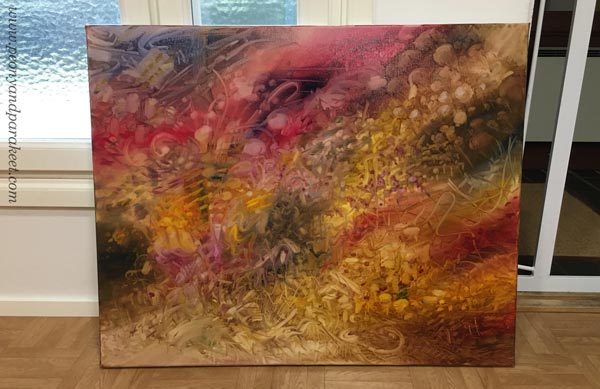
But then slowly, the colors got stronger, and shapes began to stretch in all directions.
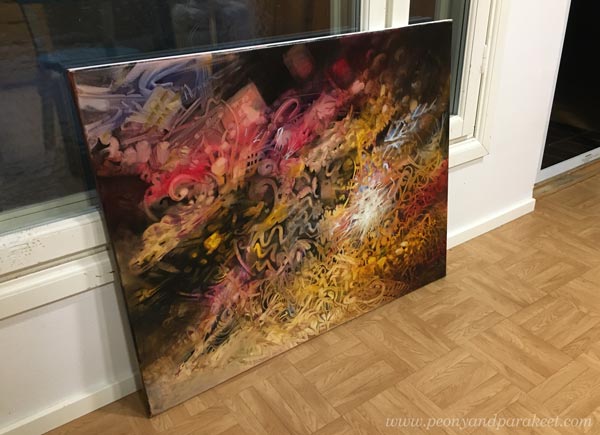
The pet had become a beast, and I couldn’t control it anymore.
Emotional Catharsis – Letting Go of Control
Just before I was about to give up the fight, Wassily stepped towards and said: “What was it like as a teenager before you chose money” He was pointing me with a brush that had Ultramarine Blue and Cadmium Red. The colors that I used so often back then.
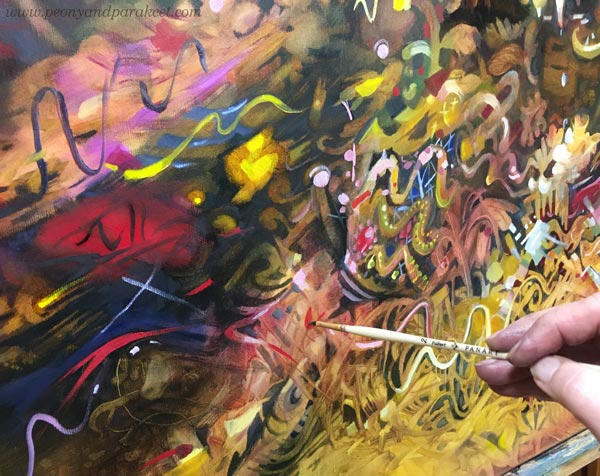
“Not now, Wassily, I can’t be weak now. I have this beast to handle”, I gulped, pointing towards the painting. But he grabbed my hand and, unlike his usual self, brutally fed it to the growing lion. The pain took over, the colors splashed uncontrollably, and for a short time, moments of my life ran through me when the lion ate me bit by bit. I was a teenager trying to find her painting style and become an artist. A young adult losing her parents and, as a result, counting pennies.
But then, just before the last ray of light burned out, I heard Wassily’s demanding voice: “You are not dead yet. Open your eyes and finish the painting.”
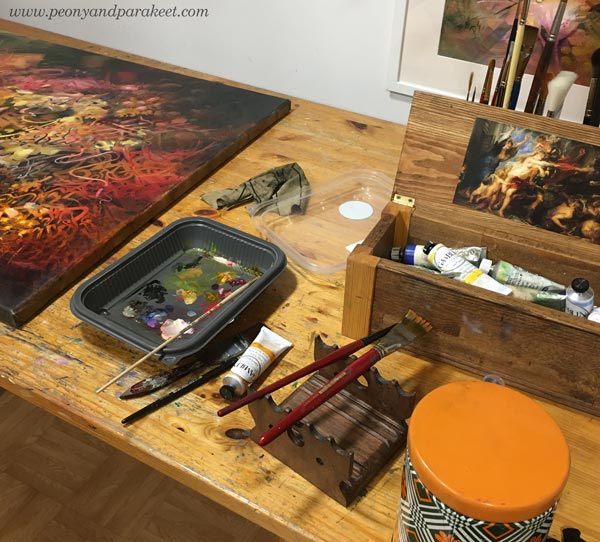
Days went by, and I visited the painting now and then like it would be a rare animal in a cage. Something had happened, but what? Wassily got frustrated: “Can’t you see it? It’s vanitas!”
Vanitas – Emotional Catharsis Explained
Vanitas paintings are still lives that express the inevitability of death in symbols. They were in fashion in the Netherlands in the early 17th century, but they have inspired artists later too.
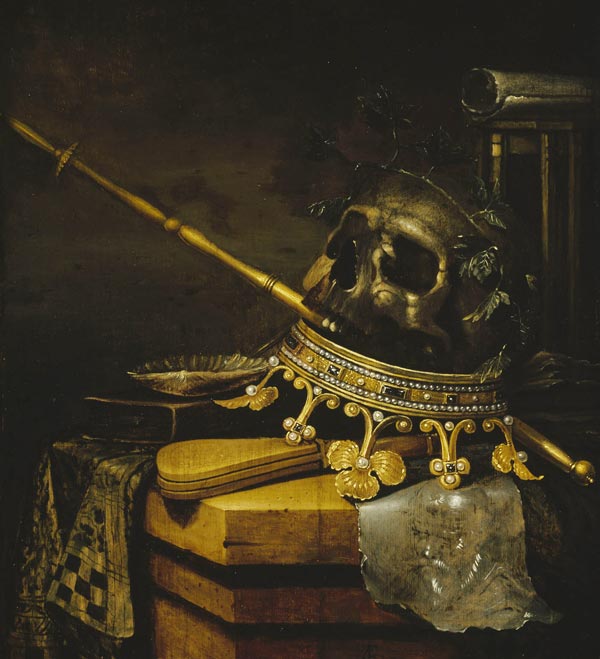
Suddenly, my lion shrank to only a skull, and there were bubbles, smoke, candles, musical instruments, playing cards, flowers, a bowl … all kinds of historical symbols for the futility of pleasure and certainty of death. Now finishing was easy. I just made the objects a little more distinct.
Here’s the closeup of the lion skull.
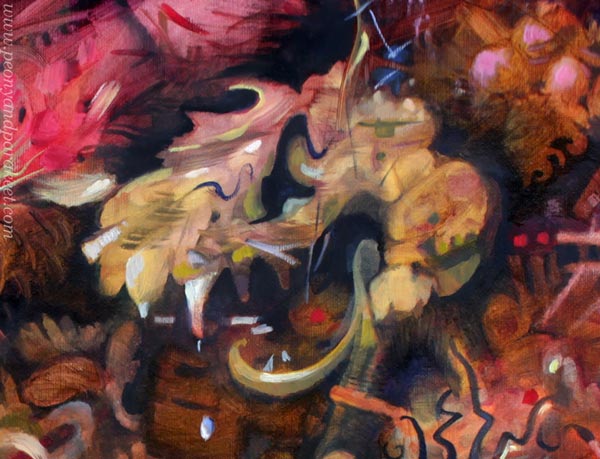
Playing cards are flying in the air.
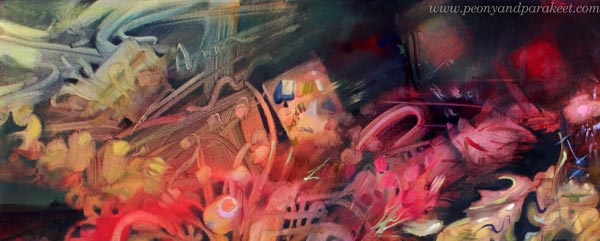
Here’s the crown, thrown in the mud.
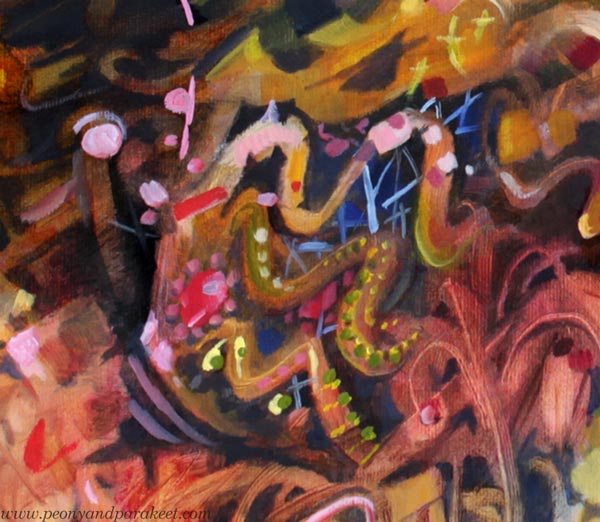
If you look carefully, you can also find lots of other symbols too. For example, a red bowl in the middle broken by icy water. And the yellow bottom expresses musical instruments and their sounds.

My favorite part is what the imaginary Wassily painted:
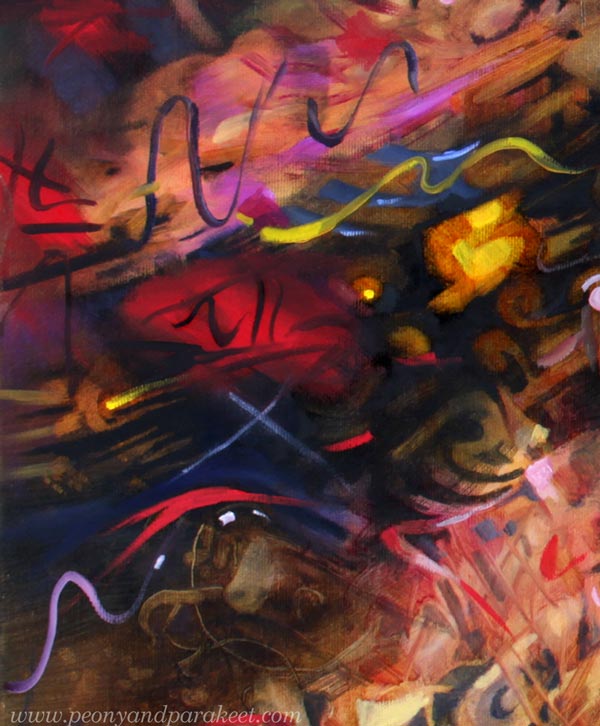
“This is how money looks like,” said Wassily in his teaching voice. “Don’t feel pity or fear about it anymore. Now you are free to paint whatever you want.”
– “I want to paint a couple of big floral still lives inspired by the 17th-century Dutch masters!” The relief and enthusiasm filled my mind.
– “Whatever,” yawned Wassily. Clearly, it would not have been his choice, but I hope he’ll keep sticking around anyway.
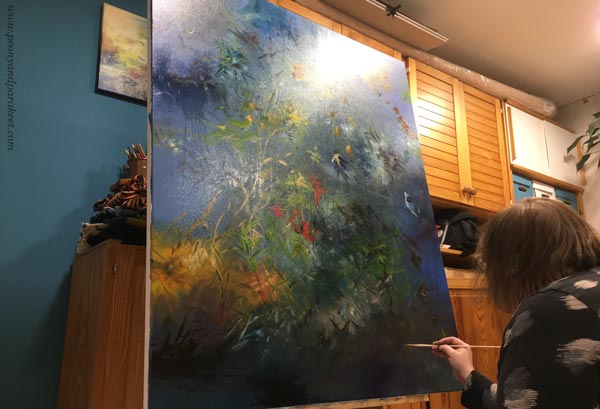
Have you ever experienced emotional catharsis through art-making? So, feeling purified after going through the climax of negative emotions? Do you always create for beauty or do you like to step to the other side too?